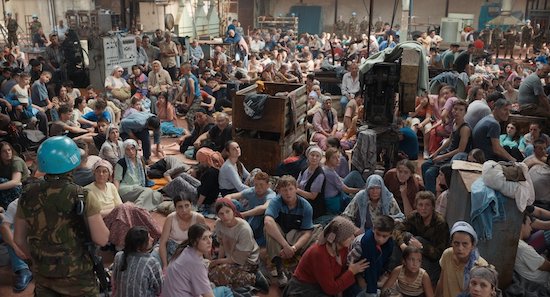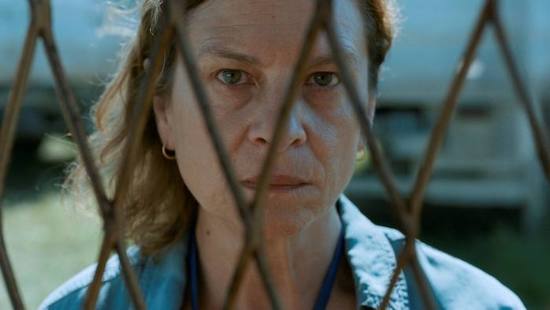There are moments in Jasmila Žbanić ’s Quo Vadis, Aida? – a nominee for Best International Feature Film at this year’s Oscars – that are hard to watch. Scenes so tense and distressing that it’s tempting to look away.
In July 1995, the Bosnian Serb army, under the command of Ratko Mladić, overran the town of Srebrenica. This was supposed to be a ‘safe zone’ and its frightened civilians descended on the nearby UN base for protection. In the end, over 8,000 men and boys were taken away on buses and killed, their bodies buried in mass graves. This was the worst act of genocide to be committed in Europe since the Second World War, and 25 years later and the process of identification and burial still continues. At last year’s commemoration ceremony, a further nine funerals took place.
Žbanić ’s film recounts these events through the eyes of one woman, Aida, a schoolteacher working at a translator at the UN base. As hundreds of people pour into the base and thousands more gather outside the gates, she becomes increasingly afraid for the safety of her husband and sons. She pulls whatever strings she can to try and protect them, while still carrying out her role as translator, offering empty reassurances to the civilians and acting as a bridge between the Dutch peacekeeping forces and Mladic’s men. She sees with increasing clarity what is coming.
The act of seeing, of witnessing, is central to Žbanić ’s film. The storytelling is claustrophobic and relentless, with Jasna Duricic, an acclaimed Serbian stage and screen actress, giving an unwavering performance – determined, contained. She knows she is her family’s best chance of survival and that knowledge weighs on her. You can see it in her face as she races through the base trying to persuade the ineffectual UN officers to help her.
But the imposing general Mladić, played with a mix of swagger and calculation by prolific Serbian actor Boris Isaković, is shown to be in total control of the situation as well as his image, sending his men to dole out bread, cooing at babies, staging ‘negotiations’. A camera is constantly present, and he is always mindful of its eye, telling the cameraman what to shoot.
While unquestionably harrowing, this is also a film of great restraint. It resists showing any violence on screen. It maintains a degree of distance from the horror, the bloodshed, the stink, the people in the compound forced to shit in close proximity to one another due to the lack of toilet facilities. It also resists narrative tidiness. Aida uses her status as a UN employee and every advantage available to her to try and save her family, knowing that a similar fate awaits all the others outside. She knows she cannot save everyone, so she focuses on those closest to her. When she spots a former student among Mladic’s men, there is a sense of awkward recognition between them, deftly illustrating how friends, colleagues and neighbours found themselves on either side of a bloody divide.
As powerful as the film is, it inevitably has an extra layer of resonance for those with lived experience or familial memory of the war. For the critic Fedor Tot, born in Novi Sad but now based in Wales, what is exceptional about Quo Vadis, Aida? is how carefully constructed it is. “I know that sounds glib, but Zbanic’s screenplay and her direction go to great lengths to place the viewer in a really difficult, anxiety-inducing state of mind,” he says. The decision to refrain from showing violence is crucial too. “It prioritises the humanity of the victims and the survivors, rather than wallowing in their suffering.”

25 years after the Dayton agreement brought an end to the war, the country remains divided into two entities, the Federation of Bosnia and Herzegovina and the majority Serb Republika Srpska. It displaced a generation and remains present, like background noise, in the everyday life of its people – and yet it is in many ways unprocessed. It does not help that governments of the countries involved tend to downplay the atrocities and foreground their own victimhood, and that many of the people involved in the regimes of the time still hold positions of power.
UK-based playwright Igor Memić, winner of the Papatango prize for his play Old Bridge (which is set in his hometown of Mostar) found the film devastating. It provoked a visceral reaction, but given that the majority of films from the region which reach a Western audience are about the war, it can also lead to what he terms “tragedy fatigue.” He explains: “The wars ended so abruptly and there was no closure. There was no forgiveness. There was no truth and reconciliation.” People had to carry on living their lives. Because there was no justice in politics, it was left to writers, artists and activists to address that injustice. Cinema, theatre, and literature can feed a need for dialogue, for reckoning, and even for healing, that the state has been unable or unwilling to meet.
There have been films made about the wars of the 1990s since almost immediately after they ended. Danis Tanović ’s No Man’s Land – a tense, blackly comic parable about two injured soldiers caught between enemy lines – is one of the most famous, winning the Best Foreign Film Oscar in 2001, but there has also been a huge number of films made in the countries of the former Yugoslavia about the conflicts over the years; some compassionate and nuanced, others clumsy and given to nationalist excess. Emir Kusturica’s surreal Underground occupies an uneasy space between the two. Made in 1995 and breathlessly hurtling through several decades of Yugoslav history in a little under three hours, it is now coloured by its director’s complex, contrarian reputation and has been accused of being irredeemably tainted with Yugonostalgia and nationalism. But it’s more complex than that, a film in which celebration and critique are problematically – and to my mind, fascinatingly – entangled.
Tot also rates Ademir Kenovic’s 1997 film Savrseni Krug (The Perfect Circle) – the first film to be made in independent Bosnia – and Pjer Zalica’s Kod Amidze Idriza (At Uncle Idris’s) as contenders for the best post-war Bosnian film.
Memic articulates the paradox that while it is important to tell stories of the war, of what led the country to that point and what came afterwards, there is also a wish – and a need, particularly among younger people – to see other stories being told. “I would just love to see something about our part of the world that isn’t just drenched in sadness,” he says.
Western films have also used the wars either as exotic backdrops – like the 1997 Clooney-Kidman vehicle The Peacemaker – or as shorthand for villainy. Dennis Hopper’s antagonist in the very first season of 24 was referred to as the Butcher of the Balkans, though you wouldn’t know it from his accent. Even the sensitively-handled ones that have engaged more directly with the conflict, like Michael Winterbottom’s Welcome to Sarajevo, tend to paint in broad strokes. The films made in the region offer the most nuanced, blackly comic, and unflinching accounts of the war and its consequences.
Take Žbanić s own 2006 debut feature, Grbavica, released in the UK as Esma’s Secret. This was one of the first films to confront the psychological aftermath of the systemic rape of women during the Bosnian war and the way it was used as a weapon. Like Quo Vadis, Aida?, it is a film about the need to look at things even if it is painful to do so. When genocide is downplayed by those in power, when Bosnian Serb songs are appropriated by far-right groups, when murals of Ratko Mladic appear on walls, it is essential to keep looking.
The film’s most evocative scene comes near its end. Aida, a schoolteacher once again, oversees a group of young children who play a game in which they repeatedly cover and uncover their eyes, endlessly looking and not looking. As the film so vividly illustrates, though it may be painful, there are some things from which we cannot afford to look away.
Quo Vadis Aida? is available to watch across the UK via Curzon Home Cinema now



